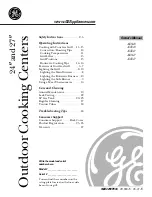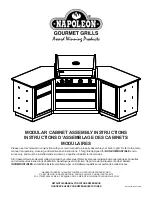
Page 22
Checking the gas type and supply
Before assembling your barbeque, you should ensure your barbeque is suited to the type of
gas which you are going to use. This is a low pressure barbeque and must only be used with
propane gas only using the hose and regulator supplied. Your barbeque is designed for use
with 4kg or 9Kg refillable propane cylinders. The cylinder should be filled by a filled by a
reputable gas supplier and visually inspected at each filling.
LPG, also known as Propane or Universal LPG:
This barbeque is suited to Universal LPG (Propane with any proportion of Butane) and has a
red sticker on the side saying
“UNIVERSAL LPG”.
This is most commonly supplied as
propane in a portable 4 kg or 9 kg gas cylinder, which can be refilled or swapped at petrol
stations or your place of purchase when empty. Follow the assembly instruction steps for how
to fit and connect your portable gas cylinder.
Some homes have twin 45 kg LPG cylinders permanently installed near an outside wall.
These cylinders supply LPG gas to multiple appliances in the home via copper pipes, and are
filled as required by the gas supply company.
Natural Gas:
This barbeque is
not approved or suitable for Natural Gas use
. It is dangerous to try and
use the wrong type of gas supply or connecting hose.
Fixed LPG Supply:
Barbeques which are connected to twin 45 kg LPG cylinders must be installed by a licensed
gasfitter, in accordance with the requirements of AS 5601, and local gas authority
requirements.
There are two approaches to installation:
(1)
Permanent Piped Connection:
Your barbeque may be permanently connected to LPG
cylinders via copper pipe. This must be done entirely by the gasfitter, in accordance with
requirements of AS 5601, and local gas authority requirements. Your gasfitter will ensure that
your barbeque is permanently connected to the supply via copper pipe, the gas pressure in
the lines is adequate, pipe sizes are correct, all connections are secure, and that all
necessary components (such as secondary regulators and manual shutoffs) are included
where regulations require them. Once this is done, the barbeque cannot be moved. It is a
permanent fixture of the property.
(2
) Bayonet Point:
Alternatively, you can have the gas fitter terminate the gas line using a
“bayonet point”. This allows you to connect and disconnect the barbeque using a special
hose and bayonet termination. For LPG installations, an appropriate hose is available from
most barbeque retailers.
Barbeque connected to
twin 45kg LPG cylinders.
Copper pipe brings the
gas from the tanks to the
barbeque area. A flexible
hose connects to a
bayonet fitting near the
appliance.
Содержание ALFRESCO Series
Страница 31: ...Page 31 Cooking times continued ...
Страница 35: ...Page 35 Exploded Drawing Part List for G4ALF2 ...
Страница 38: ...Page 38 Exploded Drawing Part List for G6ALF2 ...
















































